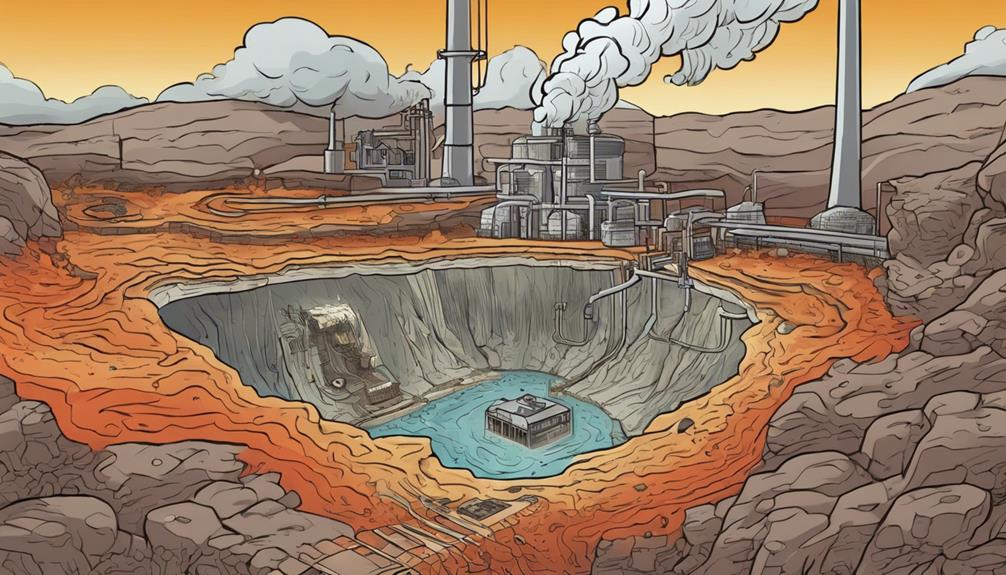You're calculating the lattice energy of CaF2, which represents the energy change involved in forming a solid crystal lattice from gaseous ions, specifically the process of calcium ions (Ca²⁺) and fluoride ions (F⁻) coming together to form solid calcium fluoride. This energy change occurs when you bring these gaseous ions together to form a solid crystal lattice. It's crucial to take into account the gas phase states of these ions in your calculation to obtain an accurate lattice energy value. Now that you understand the process involved, you can begin developing a deeper comprehension of what influences the lattice energy of CaF2.
Key Takeaways
- Lattice energy is the energy change in forming an ionic crystal (CaF2) from gaseous ions (Ca²⁺ and F⁻).
- The energy change represents the strength of ionic bonds in CaF2, with higher lattice energy indicating stronger bonds and more stability.
- The process involves the formation of a solid crystal lattice from gaseous calcium and fluoride ions, releasing energy in the process.
- The lattice energy equation requires gas phase ions of calcium and fluoride to accurately calculate the energy change.
- The energy change is a chemical reaction where calcium fluoride is the product, and precise calculations rely on considering gas phase ions.
Understanding Lattice Energy
Frequently, you'll come across lattice energy referred to as the energy change associated with the formation of one mole of an ionic crystal from its constituent gaseous ions. But what does this really mean? Essentially, lattice energy represents the strength of the ionic bonds in a compound like calcium fluoride (CaF2).
It's the energy released when gaseous ions come together to form a solid crystal lattice. The higher the lattice energy, the stronger the ionic bonds and the more stable the compound. When you understand lattice energy, you'll gain insight into the properties and behavior of ionic compounds like CaF2.
Think of lattice energy as a measure of the energy required to break apart the crystal lattice. The higher the energy, the more stable the compound. In the case of CaF2, its lattice energy is a key factor in its stability.
Components of Calcium Fluoride

When calculating the lattice energy of calcium fluoride, you need to focus on the important components: calcium and fluoride ions in their gas phase states. These ions are pivotal for determining the energy change involved in the process.
As you explore the lattice energy of CaF2, it's crucial to take into account the individual components that make up the compound.
Here are the key points to keep in mind:
- Calcium ions (Ca²⁺): These positively charged ions play a vital role in the lattice energy calculation.
- Fluoride ions (F⁻): The negatively charged fluoride ions are necessary for balancing the equation and determining the energy change.
- Gas phase states: Both calcium and fluoride ions must be in their gaseous phase states for accurate lattice energy calculation.
- Charges matter: The charges of calcium and fluoride ions are essential in determining the energy change involved in the process.
Lattice Energy Equation Requirements

Now that you've got a handle on the components of calcium fluoride, it's time to focus on the lattice energy equation requirements.
You'll need to guarantee you're working with gas phase ions of calcium and fluoride to get an accurate calculation.
Your goal is to set up an energy change equation that accurately reflects the chemical reaction, so let's get started!
Gas Phase Ions
You need gas state ions of calcium and fluoride to precisely calculate the lattice energy of CaF2, as these ions are the building blocks of the equation. Without them, you can't establish the energy change needed for the reaction.
The presence of gas state ions is vital, as they allow you to balance the equation and guarantee mass and charge conservation. This, in turn, enables you to calculate the lattice energy accurately.
Here are the key reasons why gas state ions are essential:
- Precise calculations: Gas state ions provide the necessary data for exact lattice energy calculations.
- Energy change determination: The gas state ions help you determine the energy change needed for the reaction.
- Balancing the equation: You need gas state ions to balance the equation and guarantee mass and charge conservation.
- Product formation: The product in the lattice energy equation is calcium fluoride, which requires gas state ions for calculation.
Energy Change Equation
To accurately calculate the lattice energy of CaF2, you need to formulate an energy change equation that accounts for the energy needed to form the ionic solid from its constituent gas phase ions. This equation involves the energy change in a chemical reaction, where calcium and fluoride ions in the gas phase combine to form calcium fluoride. It's important to balance the equation to confirm mass and charge conservation in the process.
You should start by writing the reactants, which are the gas phase ions of calcium and fluoride. Then, write the product, which is calcium fluoride. Remember, accuracy in lattice energy determination requires the ions to be in the gas phase.
The energy change equation will ultimately provide the lattice energy of CaF2, which is the energy needed to form the ionic solid from its constituent gas phase ions.
Gas Phase Ions Importance

When calculating the lattice energy of CaF2, gas phase ions of calcium and fluoride are essential. Their presence is necessary for accurate lattice energy calculations, ensuring you get a precise value.
Gas Phase Ion Necessity
What's the secret to precise lattice energy calculations for CaF2? It lies in the presence of gas phase ions of calcium and fluoride. You see, these ions are essential for determining the lattice energy of CaF2, and they must be in the gas phase to do so. Without them, your calculations will be inaccurate.
Here are four key reasons why gas phase ions are a necessity:
- Balancing the equation: Gas phase ions are necessary for balancing the equation for lattice energy, which involves adjusting coefficients of these ions.
- Exact determination: The presence of gas phase ions ensures the exact determination of lattice energy for CaF2.
- Precision relies on them: Precision in lattice energy calculation relies heavily on the presence of gas phase ions.
- No replacement: There's no replacement for gas phase ions when it comes to determining the lattice energy of CaF2.
In short, if you want to get your lattice energy calculations right, you need gas phase ions of calcium and fluoride. They're the key to ensuring accurate results.
Accurate Lattice Energy
You're now ready to explore how the presence of gas phase ions of calcium and fluoride directly impacts the accuracy of lattice energy calculations for CaF2. These ions play a pivotal role in maintaining precision in determining lattice energy.
When balancing the equation, it's crucial to adjust the coefficients of the gas phase ions to uphold conservation of mass and charge. By including these ions in the equation, you can depend on accurate lattice energy calculations.
The inclusion of gas phase ions of calcium and fluoride is essential for precise lattice energy calculations. It's not just about balancing the equation; it's about upholding the fundamental principles of chemistry.
Essential Calcium Fluoride
In the pursuit of accurate lattice energy calculations, incorporating gas phase ions of calcium and fluoride is important, as they greatly impact the accuracy of the final result. As you explore the world of lattice energy, you'll realize that these ions play a vital role in determining the energy change for the process. Calcium fluoride, the product in the lattice energy equation, is necessary for precise calculations.
Here are some key points to keep in mind:
- Gas phase ions are vital: Calcium and fluoride ions in the gas phase are essential for accurate lattice energy calculations.
- Conservation of mass and charge: Balancing the equation involves adjusting coefficients to ensure the conservation of mass and charge.
- Presence of calcium fluoride: The presence of calcium fluoride as the product in the lattice energy equation is crucial.
- Gas phase ions' significance: Gas phase ions play an important role in determining the lattice energy of calcium fluoride.
Balancing the Equation Process

To accurately calculate the lattice energy of CaF2, you must carefully balance the equation by adjusting the coefficients of reactants to guarantee mass and charge conservation. This step is vital, as it confirms that the number of atoms of each element and the total charge are the same on both the reactant and product sides of the equation.
| Reactant/Product | Formula | Phase |
|---|---|---|
| Calcium | Ca | Gas |
| Fluoride | F2 | Gas |
| Calcium Fluoride | CaF2 | Solid |
In the balanced equation, you'll notice that the reactants are in their gas phase, which is important for accurate lattice energy calculations. The product, calcium fluoride, is in its solid phase. By adjusting the coefficients, you'll guarantee that the equation is balanced, and you can proceed with calculating the lattice energy of CaF2. Remember, precision in balancing the equation is key to achieving accurate results in lattice energy determination.
Energy Change in Reaction

Now that you've confirmed the equation is balanced, let's examine the energy change in the reaction, which is an essential aspect of lattice energy calculations. This energy change involves the formation of calcium fluoride (CaF2) from its constituent ions.
Understanding this energy change is important because it directly affects the lattice energy of CaF2. Here are some key points to keep in mind:
- Energy change is a chemical reaction: Lattice energy involves the energy change in a chemical reaction, which in this case, is the formation of CaF2.
- Calcium fluoride as the product: The equation for lattice energy features calcium fluoride as the product, highlighting its significance in the reaction.
- Accurate calculations require gas phase ions: Gas phase ions of calcium and fluoride are required for accurate lattice energy calculations, emphasizing their essential role in the process.
- Energy change affects lattice energy: The energy change in the reaction directly impacts the lattice energy of CaF2, making it an important aspect of the calculation.
Gas Phase Ion Significance

You'll find that gas phase ions of calcium and fluoride play a vital role in guaranteeing the precision of lattice energy calculations. These ions are essential for obtaining dependable results, as they directly impact the energy change in the lattice energy equation. To understand their significance, let's break down the importance of gas phase ions in lattice energy calculations.
| Ion | Charge | Quantity |
|---|---|---|
| Ca²⁺ | +2 | 1 |
| F⁻ | -1 | 2 |
| CaF₂ | 0 | 1 |
As shown in the table, balancing the equation involves considering the charges and quantities of gas phase ions. The presence of these ions guarantees the reliability of the lattice energy equation, and their inclusion is directly related to the accuracy of lattice energy determination. You'll notice that gas phase ions play a key role in determining the energy change in the lattice energy equation. By acknowledging their significance, you'll be better equipped to tackle lattice energy calculations with confidence. Remember, gas phase ions are essential for achieving precise results, so don't overlook their importance!
Accurate Lattice Energy Calculations

By recognizing the importance of gas phase ions, you can secure accurate lattice energy calculations by applying the principles of mass and charge conservation to the equation. This guarantees that the energy change in the chemical reaction is accurately represented.
As calcium fluoride serves as the product in the lattice energy equation, it's vital to get the calculations right.
To achieve this, you need to:
- Balance the equation: Adjust coefficients to secure conservation of mass and charge.
- Focus on the energy change: The lattice energy equation revolves around the energy change in the chemical reaction.
- Consider the product: Calcium fluoride is the product in the lattice energy equation, so its formation is key.
- Don't overlook gas phase ions: Their presence is essential for accurate lattice energy determination.
Frequently Asked Questions
What Is the Lattice Energy of Caf2?
You're wondering what the lattice energy of CaF2 is – it's the energy change involved in forming solid calcium fluoride from its gas phase ions. You'll need to calculate it using the charges, sizes, and distances of the ions in the crystal lattice.
What Is the Lattice Energy of Caf2 and Cao?
You're comparing the lattice energy of CaF2 and CaO, which depends on the electrostatic attraction between ions. CaF2 has a higher lattice energy due to the stronger attraction between Ca2+ and F- ions, whereas CaO has a weaker attraction between Ca2+ and O2- ions.
What Is Lattice Energy Affected By?
You find that lattice energy is affected by several factors, including the charges of the ions involved, their size, arrangement in the crystal lattice, and the distance between them, all of which impact the overall energy.
How Does Lattice Energy Change Across a Period?
As you venture across a period, imagine atomic size shrinking like a deflating balloon, while nuclear charge inflates like a pumped-up muscle – you'll notice lattice energy increasing, driven by stronger ionic attractions and shorter distances between ions.
Conclusion
As you've navigated the labyrinth of calcium fluoride's lattice energy, you've unraveled the intricacies of this complex process.
The energy change for the process of converting solid calcium fluoride into its constituent gas-phase ions holds the key.
With each piece of the puzzle in place, the lattice energy equation unfurls, revealing the intricate dance of ions and energies.
Now, with the gas phase ions taking center stage, you've mastered the art of balancing the equation, and the accurate calculation of lattice energy is yours to command.










